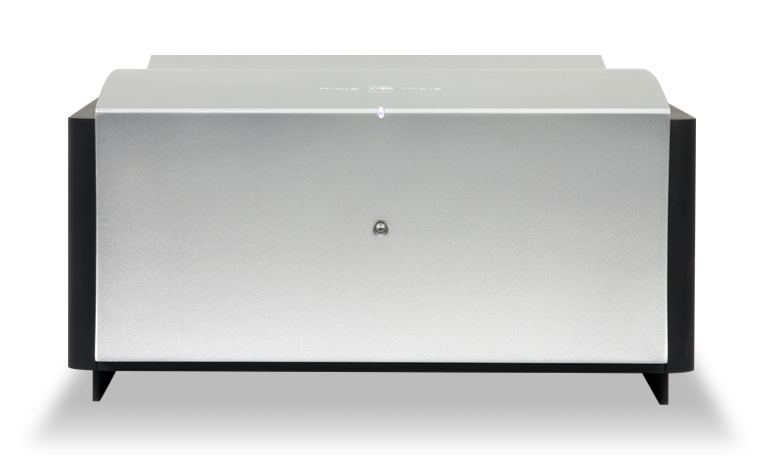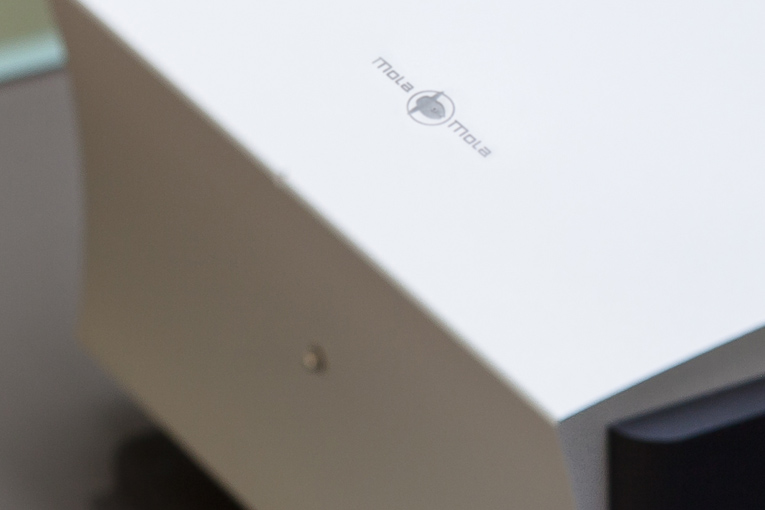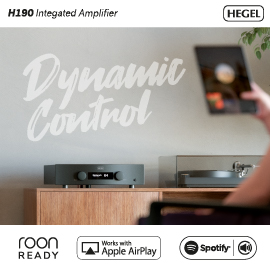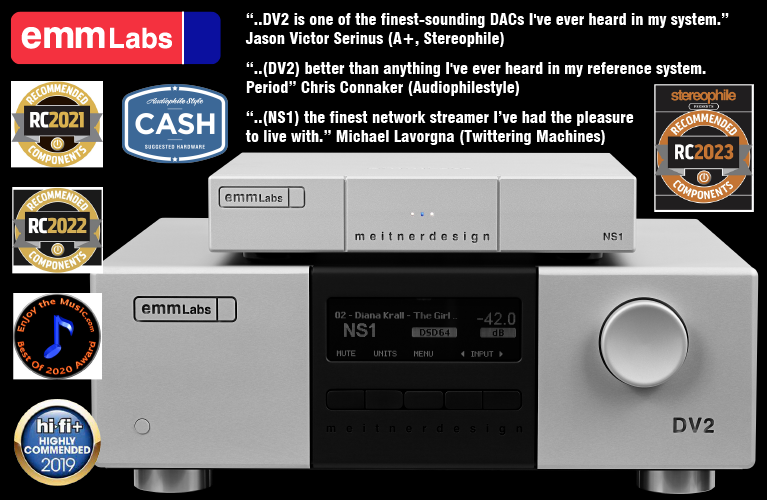Note: Measurements can be found through this link.
 As we know it today, hi-fi largely stands on the shoulders of key personalities of past decades. But whether you go all the way back to Thomas Edison, or no further than the 1970s and such luminaries as John Curl, Mark Levinson, Sidney Harman, and William Zane Johnson, or focus only on the more recent activities of designers such as Charles Hansen (Ayre Acoustics), Richard Vandersteen (Vandersteen Audio), Bob Stuart (Meridian), or Dave Wilson (Wilson Audio), it’s clear that hi-fi remains predominantly a product of the 20th century. Now, in the second half of the second decade of the 21st century, might be a good time to consider who will be most instrumental in redefining hi-fi for the remainder of this century. Who will advance 21st-century technologies while meeting the expectations and demands of the newest generations of music lovers?
As we know it today, hi-fi largely stands on the shoulders of key personalities of past decades. But whether you go all the way back to Thomas Edison, or no further than the 1970s and such luminaries as John Curl, Mark Levinson, Sidney Harman, and William Zane Johnson, or focus only on the more recent activities of designers such as Charles Hansen (Ayre Acoustics), Richard Vandersteen (Vandersteen Audio), Bob Stuart (Meridian), or Dave Wilson (Wilson Audio), it’s clear that hi-fi remains predominantly a product of the 20th century. Now, in the second half of the second decade of the 21st century, might be a good time to consider who will be most instrumental in redefining hi-fi for the remainder of this century. Who will advance 21st-century technologies while meeting the expectations and demands of the newest generations of music lovers?

Bruno Putzeys, of Belgium, is on my short list of candidates. A magna cum laude graduate of the National Technical School for Radio and Film, in Brussels, Putzeys is one of the most interesting designers of audio equipment I’ve met in the past five years, and is perhaps already the most impactful audio engineer you’ve never heard of (although his relative anonymity among consumers of high-performance audio is quickly eroding). After working the better part of a decade at Philips’s Applied Technologies Lab, in Leuven, Belgium, Putzeys tired of that huge company’s failure to heed his cries that “The future is in class-D!” and decided to spread his wings. Ever since, he’s refused to limit his talents to a particular subset of sound reproduction. Putzeys is the inventor and driving force behind Universal class-D (UcD), the subsequent Ncore amplifier modules, and various switch-mode power supplies, all made by Hypex for other audio manufacturers; Grimm Audio’s AD1 all-discrete, DSD analog-to-digital converter, LS1 loudspeaker, and related professional audio electronics; and Kii Audio’s Three loudspeaker. Putzeys also developed the amplifiers, preamplifiers, and DACs made by Mola Mola, a consumer-audio brand he established, with Jan-Peter van Amerongen, to push boundaries and maximize the efficacy of his electronics designs.
The influence of all this work has extended beyond the confines of these companies. The Grimm AD1 has been recognized as a reference-level ADC, and in the past decade has found favor with such celebrated recording engineers as Jared Sachs, of Channel Classics Records. Similarly, while Hypex’s supplying of highly efficient, musically satisfying UcD amplifier modules to other manufacturers has had a long-running impact on the audio industry, their state-of-the-art Ncore modules have shaken up the pecking order as the apparent top choice for absolute performance. Forgoing the class-D ICE amplification modules from Bang & Olufsen that they previously used, firms such as Bel Canto Design, Jeff Rowland Design Group, NAD, Theta Digital, and a number of others have turned to Ncores for their top-tier amplifier models.
The subject of this review is Mola Mola’s Kaluga monoblock amplifier ($16,500 USD per pair), an elegantly liveried class-D amplifier of diminutive proportions and prodigious specifications. I’d originally hoped to review the Kaluga in 2014, after spending quality time listening to prototypes of it drive a pair of Vivid Audio’s Giya G3 speakers at the 2014 Consumer Electronics Show. While the Kaluga’s essential design elements have been firmly established for some time (it was demonstrated in nearly final form for several years), the definitive version didn’t go into production until 2015. The delay was apparently due to the inability of Putzeys and van Amerongen to find a machine shop capable of milling the case with the precision they demanded. But, at last, a pair of Kalugas was in my possession. I hoped they would prove to be an instance of good things coming round to him who had but waited.
Defining perfect
The casework dilemma finally solved, Bruno Putzeys conceded that his biggest frustration was “just not being able to explain to people what the word perfect means.” What made the Kaluga’s seemingly simple enclosure so difficult to produce? As far as I can see, a combination of three things: crazy-tight tolerances; the undulating scallops of the single piece of metal comprising its front and top panels; and the consistency of the bead-blasted finish, its two-tone anodizing contrasting the nearly white front and top against the dark-gray skirts of the side panels. The case is a Chinese puzzle box, that combo front-and-top panel machined from a single block of metal and covering the Kaluga’s guts and making a seamless join with its side and rear panels; the entire case is devoid of visible fasteners.
The surface of the Kaluga’s subtly concave faceplate is interrupted only by a small, stainless-steel ball bearing at its center. This is the On/Standby button; directly above it, midway along the faceplate’s front edge, a tiny blue LED indicates operational status. Beginning about an inch back from the front edge, the Mola Mola logo is deeply etched into the top panel. On the rear of each monoblock are one single-ended (RCA) and one balanced (XLR) input, separated by a switch to select between them, two pairs of premium Furutech speaker terminals (for biwiring), and a 15A IEC inlet for the power cord (included).

From its coloring to its tactile finish, from its sinuous curves to its straight side panels, the Kaluga’s seemingly simple design is reminiscent of the joinery of a Wegner chair distilled into an aluminum jewel box. At 7.8"W x 4.3"H x 13.1"D, the Kaluga is small, occupying not much more than half the volume of each of my reference monoblocks, the already compact Ayre Acoustics MX-R Twentys. And, at just 15.4 pounds each, the Kaluga weighs little more than a third as much as the Ayre. To protect them from shipping hazards, each pair arrives in a single Pelican-style flight case. Included is a pair of white microfiber gloves for handling them during setup, and an operating manual.
The Kaluga’s claimed specifications mirror the perfection Putzeys took such pains to realize in their exterior: power outputs of 400W into 8 ohms, 700W into 4 ohms, or 1200W into 2 ohms; an unweighted signal/noise ratio of 128dB; an input impedance of 100k ohms, and an output impedance of less than 0.002 ohm at any frequency; gain is a fairly customary 28dB, but there’s nothing customary about the figures for THD and IMD distortion: less than 0.003% at all frequencies and power levels. To shoehorn such robust output power into such a small enclosure and achieve such spectacular measured performance, Putzeys turned to his switch-mode power supplies and a variation of his Ncore modules. So what’s going on here?
Gobs of feedback recommended . . . if applied consistently across the audioband
Before delving into the variant of the Ncore module used in the Kaluga, a better understanding of how class-D à la Ncore differs from earlier class-D amps -- and from class-A and -A/B -- might be useful. As Bruno Putzeys corrected me several years ago, the D in class-D does not stand for digital, as is often assumed, but is simply the designation for efficient, switching, pulse-width-modulation amplification schemes that are closely related to switch-mode power-supply technology. Ever since he chose class-D as the topic for his bachelor’s-degree thesis, Putzeys has worked on advancing the topology.

Although Ncore, and UcD before it, rely heavily on feedback, Putzeys admits that, early on, he was suspicious of negative feedback. In 1999, he built a zero-feedback class-D amplifier that processed DSD directly. His initial aversion to feedback changed quite dramatically, and I asked him what had happened:
I began to form the suspicion that the sound of feedback has nothing really to do with the fact that there is feedback, but with the fact that, usually, the amount of feedback you get (called the loop gain, technically) typically decreases as you increase in frequency. So an amplifier with a massive amount of feedback at bass frequencies might actually have quite little at high frequencies, because that’s where it gets difficult. . . . Maybe that explains this very brittle, thin, choked kind of sound that is typically associated with negative feedback. . . . [F]eedback itself is not a sonic evil, but it’s how you do it. As time went on, I realized that feedback is not just one tool in the toolbox, it is the most important tool in the box. Feedback is what keeps jet fighters flying, it’s what keeps nuclear power plants from melting down, it is everywhere. . . . Indeed, I came to realize that feedback had unjustly been given a bad rap in audio, and that you could actually use it to your advantage in terms of subjective sonic result.
Putzeys freely admits, however, that with insufficient feedback, or feedback inappropriately applied, the sonic results can be disastrous:
If you take a simple amplifier which has acceptable distortion (just a second harmonic is what I use as an example) and you start applying feedback, harmonics will appear that were not there originally. Higher-order harmonics, even and odd, turn up out of the blue. So if you apply a little bit of feedback, the second harmonic that you wanted to reduce drops by a little, but out of the blue you get this whole smattering of high harmonics. It is quite understandable that this doesn’t sound good. . . . [But], if you keep increasing feedback, if you turn the feedback knob up and up and up, you quickly hit a point where those distortion products all start coming down again and the signal does start getting cleaner. And if you get to very large amounts of feedback, the result is just supersmooth.
UcD was the result of Putzeys’s commitment to marry to class-D large amounts of feedback, evenly applied across the audioband. Ncore builds from there. He explained: “UcD had substantial loop gain up to 20kHz of 35dB or something -- and I wanted to go beyond that. As I said, there is no such thing as too much feedback, so I was looking for a way to add 20dB more . . . 50 or 60dB of audioband loop gain.” Yet he recognizes that, even with the benefits of massive feedback, the starting point of the audio circuit must be sound: “You have to start out with something good, because there is always a trade-off. . . . [I]f you can also get 10dB improvement in open-loop distortion, why not do so?”

It stands to reason that if the potential contained within the Ncore module could be fully exploited, how to do so might come from the mind of the technology’s inventor. Who better to understand its strengths, limitations, and untapped opportunities? In the Kaluga, you won’t find a stock Ncore 1200 amplifier module. Rather, a hot-rodded adaptation is used. As in a Formula 1 car, in which each subassembly is taken to an extreme, the audio circuitry on the Kaluga’s amplifier board is “trimmed to the bare bones and board-to-board connectors are eliminated in favor of soldering a pair of star-quad cables directly into the circuit board of the cleanest, lowest impedance connection possible.” Rather than the all-in-one module sold to OEM customers, the Kaluga’s input stage is separated and discrete buffers employed. The output filter, too, was redesigned for the Kaluga, which also uses monolithic capacitors with higher levels of dielectric stability.
Great care has also been applied in Putzeys’s design of the accompanying switch-mode power supply, to ensure immense reductions of outside EMI and RFI noise while maximizing the quality of DC the supply feeds the audio circuitry. “You really need to be extremely careful with external noise,” he explained, “because a lot of audio equipment is astonishingly sensitive, sonically, to any of [the] high-frequency noise circulating around power cables, speaker cables, and interconnects. . . . [B]ut obviously, just plainly, the quality of the DC itself matters just as much.” To that end, the Kaluga not only conforms to but greatly exceeds the AES48 standard of extreme isolation from noise used in professional audio.
The sound of silence, weight, and total control
My review samples of the Kaluga had already seen plenty of use. This meant that I couldn’t test their response to a long break-in period, but could begin to get their full measure straight away. Immediately, three attributes popped up, never to wane. First was their iron-fisted control over my Vivid Giya G3 speakers; second, an almost scary lack of noise (no signal = no noise whatsoever); and, third and probably most important, a dynamic transparency that was startling in its ability to render not only transient attacks, but the intertwining lines of dense soundscapes.
The Chemical Brothers’ soundtrack for the film Hanna (16-bit/44.1kHz AIFF, Back Lot Music/Relativity Music Group) is one of my favorite finds of the past few years -- “Bahnhof Rumble” and “The Devil Is in the Beats” provide excellent tests of bass control, soundscape layering, and dynamic impact. Yet first impressions can be deceptive. Beyond electronica, the low-bass notes from jazz musicians’ double basses and the timpanic thwacks of symphonic spectaculars confirmed the Kalugas’ control to be as fully able to convey the texture, nuance, and decay captured on recordings, with no hint of one-note bass. Unlike some components that initially impress, only to later reveal their reliance on surface trickery in lieu of depth of character, the Kaluga stuck with and grew on me.

One of the most overused words in describing audio components is neutral. However, you must remember that there are more than 50 shades of gray. Any of these shades may be entirely neutral, neither over- nor underemphasizing any part of the audioband, yet such neutrality in and of itself does not equate with transparency. In audio, neutrality is an honorable part of the goal of avoiding colorations -- but if it materially darkens the sound or otherwise diminishes the essence of the experience, who cares? As described above, in the Kaluga, Putzeys -- through a constant application of feedback across the audioband, the elimination of higher-order harmonic distortion, etc. -- has focused not only on the evenhanded reproduction of the input signal, but has also striven to bury any noise so far below the limits of audibility that the amplifier becomes, in essence, an unblemished, undiminished, transparent window on that signal.
The Maria Schneider Orchestra’s landmark The Thompson Fields (16/44.1 AIFF, ArtistShare) takes listeners down a lane of Schneider’s memories of her Minnesota homeland. In this artist-controlled production, the battles of the Loudness Wars are only distant rumors -- there are gobs of dynamic range in these recordings of Schneider’s compositions, moving in grand sweeps from pianissimo to fortissimo and everywhere between. Like the work of her mentor, Gil Evans, Thompson’s “The Monarch and the Milkweed” in particular taps into the artistry of her players and the sounds of their instruments, moving and shaping the soundscape from breeze to tempest. Monarch butterflies annually undertake a three-generational journey from Mexico to the northern realms of North America and back, and this work constitutes a melodically poetic depiction of the northern part of that journey. Whether I followed a single line of melody or let myself be washed in a cacophonous crescendo, Thompson’s entire jazz orchestra ablaze, the Kalugas kept their composure and control, transfixing me in my chair. The Mola Molas’ lack of noise, their robust output power, and their infinitesimal output impedance combined to present a neutrality as transparent as any I’ve heard.

If the music’s solidity, weight, and force are to be conveyed to the listener, such transparency is an absolute requirement. Too often, the surface of sound reproduction can flatter -- but a fulfilling listening experience is possible only if the underlying whole is adequately reproduced.
During the months I listened to the Kaluga, and regardless of the preamplifier used -- at first my Ayre Acoustics KX-R Twenty, then Mola Mola’s Makua, and finally Ayre’s Codex in variable output mode -- I experienced an ease that I’d hoped for but could not assume I would hear. This ease not only defied the conventional wisdom regarding the limitations of class-D sound, but embodied the sense of musical reality often attributed to and associated most closely with class-A amplification.
Class-D vs. class-A/B
Since the Ayre MX-R monoblocks have been a central part of my reference system for the better part of a decade, and as the Twenty upgrade of the MX-Rs (now $29,500/pr.) has itself been ear-opening, it was exciting to hear how far class-D, as implemented in the Mola Mola Kaluga, has scaled that height. Based on my experiences, a valid argument can be made in favor of the Kaluga, which in some parameters -- iron-fisted bass control, absolute quiet -- beats what I consider to be the best of the class-A/B topology. Both were wonderfully transparent amplifiers able to transmit the underlying performance and emotional appeal. Returning to the Ayres at the end of my listening to the Kalugas, I felt I could relax into the emotional aspect of the music through the MX-R Twentys just a skosh more -- although this was perhaps due only to my long intimacy with the Ayres’ sound. Nevertheless, and all things considered, the Kalugas, fed by their companion Makua preamp, trumped the AX-5 Twenty currently presiding over my family-room system. That such an equality of excellence can be achieved with such wildly different approaches -- zero-feedback, fully-balanced class-A/B vs. massive-feedback class-D -- is a testament to the efficacy of Bruno Putzeys’s designs.
21st-century hi-fi in an audiophile-approved form factor
Bast, in Patrick Rothfuss’s The Name of the Wind, warns an adversary not to take him too lightly: “You see light dappling on the water and forget the deep, cold dark beneath.” It would be easy to look at the little Kaluga amplifiers and make the same mistake. They may be a small instance of the monoblock category audiophiles have grown accustomed to, and they don’t weigh a ton -- or even 20 pounds each. Nevertheless, they’re sonic heavyweights, and one of the best-measuring, best-sounding amplifiers available at any price. Like its namesake fish (aka the river beluga, a sturgeon), the Kaluga can plumb the depths, sparkle in the surf, and dance everywhere in between. Unlike the fish, the Kaluga has no discernible flavor of its own, and doesn’t tire or become tiring. Twenty years ago, Bruno Putzeys professed that “The future is class-D!” Having heard his Mola Mola Kaluga monoblocks, I suppose we can declare that that future has become the present. Welcome to the 21st century.
. . . Peter Roth
peter@soundstagenetwork.com
Associated Equipment
- Speakers -- Vivid Audio Giya G3 and Giya G2
- Amplifiers -- Ayre Acoustics MX-R Twenty (monos) and AX-5 Twenty (integrated)
- Preamplifiers -- Ayre Acoustics KX-R Twenty, Mola Mola Makua
- USB digital-to-analog converters -- Ayre Acoustics Codex and QB-9DSD, Wavelength Audio Crimson Balanced
- Digital sources -- CAPS Server Zuma
- Interconnects -- AudioQuest Wild Blue Yonder, Cardas Clear
- Speaker cables -- AudioQuest WEL Signature and GO-4
- Power conditioners -- Ayre Acoustics L-5xe, Furman IT-Reference 20i
- Amp stands and rack -- Harmonic Resolution Systems M3 amp stands, SXR rack system with M3X shelves
Mola Mola Kaluga Mono Amplifiers
Price: $16,500 USD per pair.
Warranty: Three years parts and labor.
Mola Mola
Kattegat 8
9723 JP Groningen
The Netherlands
E-mail: info@mola-mola.nl
Website: www.mola-mola.nl
North American distributor:
GTT Audio
356 Naughright Road
Long Valley, NJ 07853
USA
Phone: (908) 850-3092
E-mail: av@gttaudio.com
Website: www.gttaudio.com






















